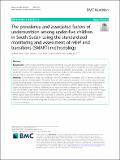The Prevalence and Associated Factors of Undernutrition among Under-five Children in South Sudan Using the Standardized Monitoring and Assessment of Relief and Transitions (SMART) Methodology
View/
Publication Date
2021-05-28Type
Article, Journalviews
downloads
Metadata
Show full item recordCitation
Kiarie, J., Karanja, S., Busiri, J. et al. The prevalence and associated factors of undernutrition among under-five children in South Sudan using the standardized monitoring and assessment of relief and transitions (SMART) methodology. BMC Nutr 7, 25 (2021). https://doi.org/10.1186/s40795-021-00425-3
Abstract/
Background Conflict regions bear the heaviest brunt of food insecurity and undernutrition. South Sudan is one of the fragile countries following years of conflict that led to large displacements. Moderate to severe undernutrition among under-five children has been associated with elevated morbidity and mortality. This study, therefore, was conducted to assess the magnitude and factors influencing undernutrition (wasting, underweight and stunting) among children aged 6 to 59 months in Yambio County, South Sudan. Methods A cross-sectional study was conducted from 26 October to 6 November 2018 in Yambio County, South Sudan among 630 children aged 6–59 months from the 348 households surveyed in 39 clusters using two-stage cluster sampling design. Data were collected using questionnaires and nutritional anthropometric measurements. The Standardized Monitoring and Assessment of Relief and Transitions (SMART) Methodology was followed to obtain the prevalence of wasting, underweight and stunting based on respective z scores and according to the 2006 world health organization child growth standards. Data were exported to Stata version 16 for further analysis. Bivariate analysis of independent variables and undernutrition was done using binary logistic regression. Mixed effects logistic regression analysis was conducted to control for possible confounders and account for random effects at household and cluster levels. Unadjusted and adjusted odds ratios (cOR and aOR) with 95% confidence intervals (CI) and p-values were computed. P-values of ≤0.05 were considered statistically significant. Results The prevalence of undernutrition explained by wasting (weight-for-height Z-score (WHZ) < − 2), underweight (weight-for-age z-scores (WAZ) < − 2) and stunting (height-for-age z-scores (WHZ) < − 2) were 2.3% (1.3–4.1, 95% CI), 4.8% (3.1–7.5, 95% CI) and 23.8% (19.1–29.2, 95% CI). Male sex (aOR [95% CI], p-value: 5.6 [1.10–30.04], p = 0.038), older child’s age (aOR [95% CI], p-value: 30.4 [2.65–347.60], p = 0.006) and non-residents (cOR [95% CI], p-value: 4.2 [1.4–12.2] p = 0.009) were associated with increased risk of wasting. Household size (cOR [95% CI], p-value: 1.09 [1.01–1.18] p = 0.029) and younger child age (cOR [95% CI], p-value: 4.2 [1.34–13.23] p = 0.014) were significantly associated with underweight. Younger child age (aOR [95% CI], p-value: 5.4 [1.82–16.44] p = 0.003) and agricultural livelihood (aOR [95% CI], p-value: 3.4 [1.61–7.02] p = 0.001) were associated with stunting. Conclusion Based on a cut off of less than − 2 standard deviations for 2006 World Health Organization (WHO) child growth standards, the wasting prevalence was very low, underweight prevalence was low while stunting prevalence was high. The county lies in the only livelihood region in South Sudan with bimodal reliable rainfall pattern and it seems that the impact of the 2016 conflicts that lead to large displacements may not have greatly affected under-five undernutrition. Interventions targeted at improving food diversity, increasing nutrition knowledge and enhancing resilience in male children might reduce undernutrition. In the short-term, investment in continued surveillance of nutritional status should be a main focus.
Subject/
Child Undernutrition; Wasting; Underweight; Stunting; Food insecurity; Conflict regions
Further Details
Open Access: This article is licensed under a Creative Commons Attribution 4.0 International License, which permits use, sharing, adaptation, distribution and reproduction in any medium or format, as long as you give appropriate credit to the original author(s) and the source, provide a link to the Creative Commons licence, and indicate if changes were made. The images or other third party material in this article are included in the article's Creative Commons licence, unless indicated otherwise in a credit line to the material. If material is not included in the article's Creative Commons licence and your intended use is not permitted by statutory regulation or exceeds the permitted use, you will need to obtain permission directly from the copyright holder. To view a copy of this licence, visit http://creativecommons.org/licenses/by/4.0/. The Creative Commons Public Domain Dedication waiver (http://creativecommons.org/publicdomain/zero/1.0/) applies to the data made available in this article, unless otherwise stated in a credit line to the data.
Publisher
BMC NutritionCollections
- General - GEN [367]

